Maria's hands shook as she held the letter from a donor. "Your food pantry saved my family during the hardest months of our lives," it read. "My children didn't go hungry because of what you do." That single story became the cornerstone of her organization’s next fundraising campaign, which raised 40% more than the previous year.
This is the power of testimonials for nonprofits. Unlike businesses selling products, your organization transforms lives, builds communities, and creates lasting change. Your testimonials aren't just customer reviews—they're evidence of hope, healing, and impact that money can't measure.
Testimonials serve a unique role in nonprofit website design. They build trust with potential donors who want to know their gifts will make a difference. They show real impact rather than just claiming it. Most importantly, they create an emotional connection between your mission and someone who might become your next champion.
This guide will walk you through everything you need to know about ethically collecting, crafting, and displaying testimonials that drive engagement and support. We'll cover the different types of testimonials that work best for mission-driven organizations, from beneficiary stories to donor endorsements.
You'll also discover how to ask for testimonials without being pushy, how to protect vulnerable populations, and how to turn these stories into a powerful tool for building your community of supporters.
Why Testimonials Are Essential for Nonprofit Websites
People give to organizations they trust. In a world where donors have countless options for their charitable giving, testimonials help you stand out by showing—not just telling—the difference you make.
The psychology behind story-driven giving runs deep. Human brains are wired to respond to narratives, especially those that feature real people overcoming challenges. Stories are remembered up to 22 times more than facts alone. And nonprofits that incorporate effective storytelling into their websites see donor retention rates that are 18% higher.
When potential donors read about someone like them who found value in supporting your cause, it removes barriers and builds confidence in their decision to give.
Testimonials fit naturally into every stage of the donor journey:
- For First-Time Visitors: Testimonials help them understand your impact.
- For Those Considering a Gift: Peer endorsements reduce anxiety about whether their donation will matter.
- For Existing Supporters: Testimonials reinforce their decision and encourage continued giving.
The key difference between testimonials and general impact stories lies in their personal nature. While impact stories might share statistics about how many people you've served, testimonials give voice to individual experiences. They put a human face on your work and help donors see themselves as part of something meaningful.
For more information about understanding your website visitors:
- User Journeys for Nonprofit Websites: Understanding and Improving the Donor Experience
- Nonprofit Website Audits: A Comprehensive Guide for Evaluation
Types of Testimonials That Work for Nonprofits
Beneficiary Stories
The most powerful testimonials come from the people you serve directly. These stories carry emotional weight that no other type of endorsement can match. When a parent talks about how your after-school program kept their child safe, or when a veteran describes finding community through your support services, donors hear the real impact of their potential gift.
However, beneficiary testimonials require special care. Age considerations matter—children's stories need different handling than adult testimonials. You'll want to balance showing meaningful impact with maintaining dignity for the people you serve.
Some beneficiaries may prefer to remain anonymous while still sharing their story. Others might be eager to put their face and name to their experience. Both approaches can work effectively when handled thoughtfully.
Empowering Storytelling: How Heifer International Highlights Magali’s Journey
Heifer International presents its impact stories with care, dignity, and a focus on individual resilience. In Magali’s story, readers learn how raising animals helped her rebuild her life after loss.
Magali shares parts of her journey in her own words through direct quotes, adding authenticity and emotional connection. While the organization explains how its training and resources played a role, the spotlight remains firmly on Magali’s determination and perseverance as the driving forces behind her success.
Vivid, respectful photography centers her joy and strength rather than her hardship.
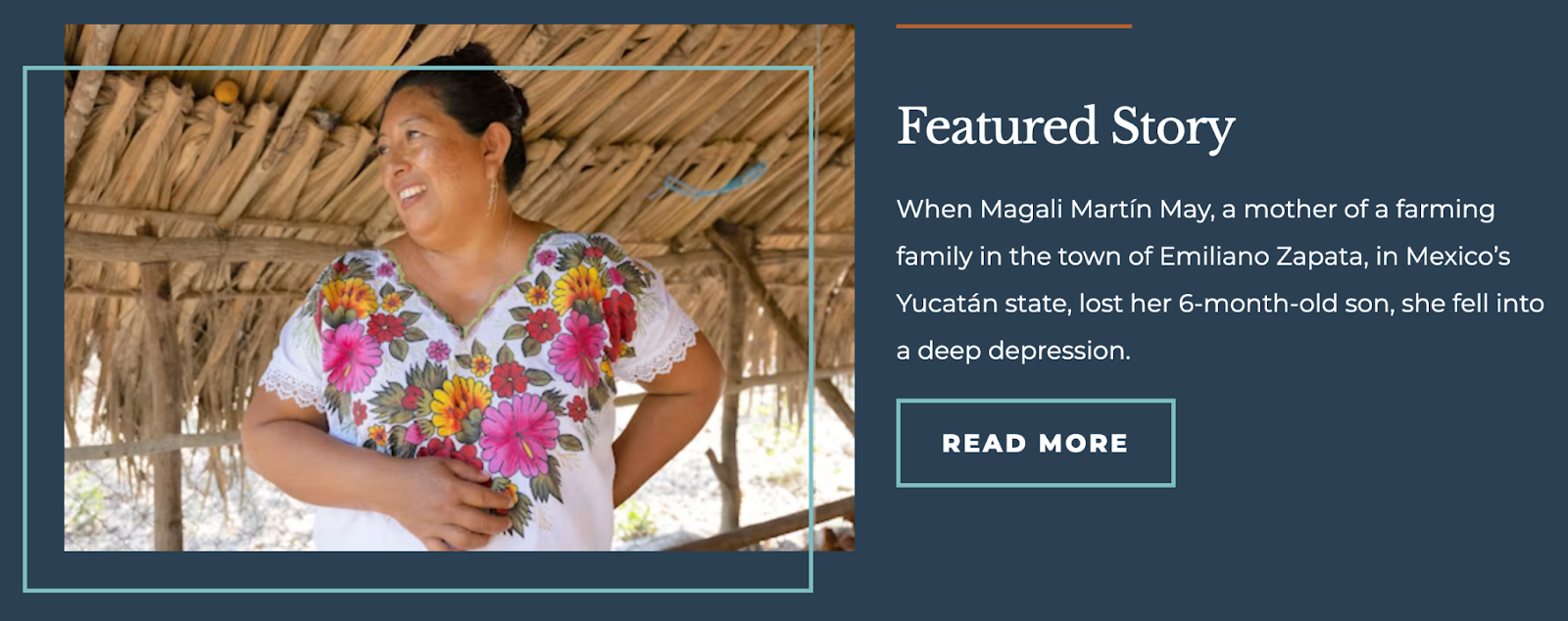
Donor Testimonials
Other donors often provide the most persuasive case for giving. When someone reads about a peer who found joy and purpose in supporting your cause, it removes the uncertainty about whether their gift will be worthwhile.
First-time donor testimonials help newcomers see that giving to your organization was a positive experience. Long-term supporter endorsements demonstrate sustained value and ongoing impact. Each type serves different audiences and stages in the donor journey.
Corporate donor testimonials add institutional credibility, especially when seeking larger gifts or grants. These endorsements show that established organizations have vetted and chosen to support your work.
Volunteer Testimonials
Volunteers offer a unique perspective because they've invested time and energy into your mission. Their testimonials carry weight because they've experienced your organization from the inside. They can speak to both the impact of your work and the quality of your team and operations.
These stories work especially well for volunteer recruitment. When potential volunteers read about meaningful experiences others have had, they're more likely to see themselves getting involved. Multi-generational volunteer perspectives can show that your organization welcomes people at different life stages.
Volunteer Voices with Depth: Habitat’s “Volunteer Spotlight” Page
Habitat for Humanity MidOhio does a great job highlighting volunteer stories on its “Volunteer Spotlight” page. Each feature gives several paragraphs to a single volunteer, sharing their background, how they got involved with the organization, and what makes the work meaningful to them.
The page showcases a wide range of volunteer ages and experiences, showing that there’s truly a place for everyone. This thoughtful storytelling gives a fuller picture of Habitat’s impact and invites others to see themselves in the mission.
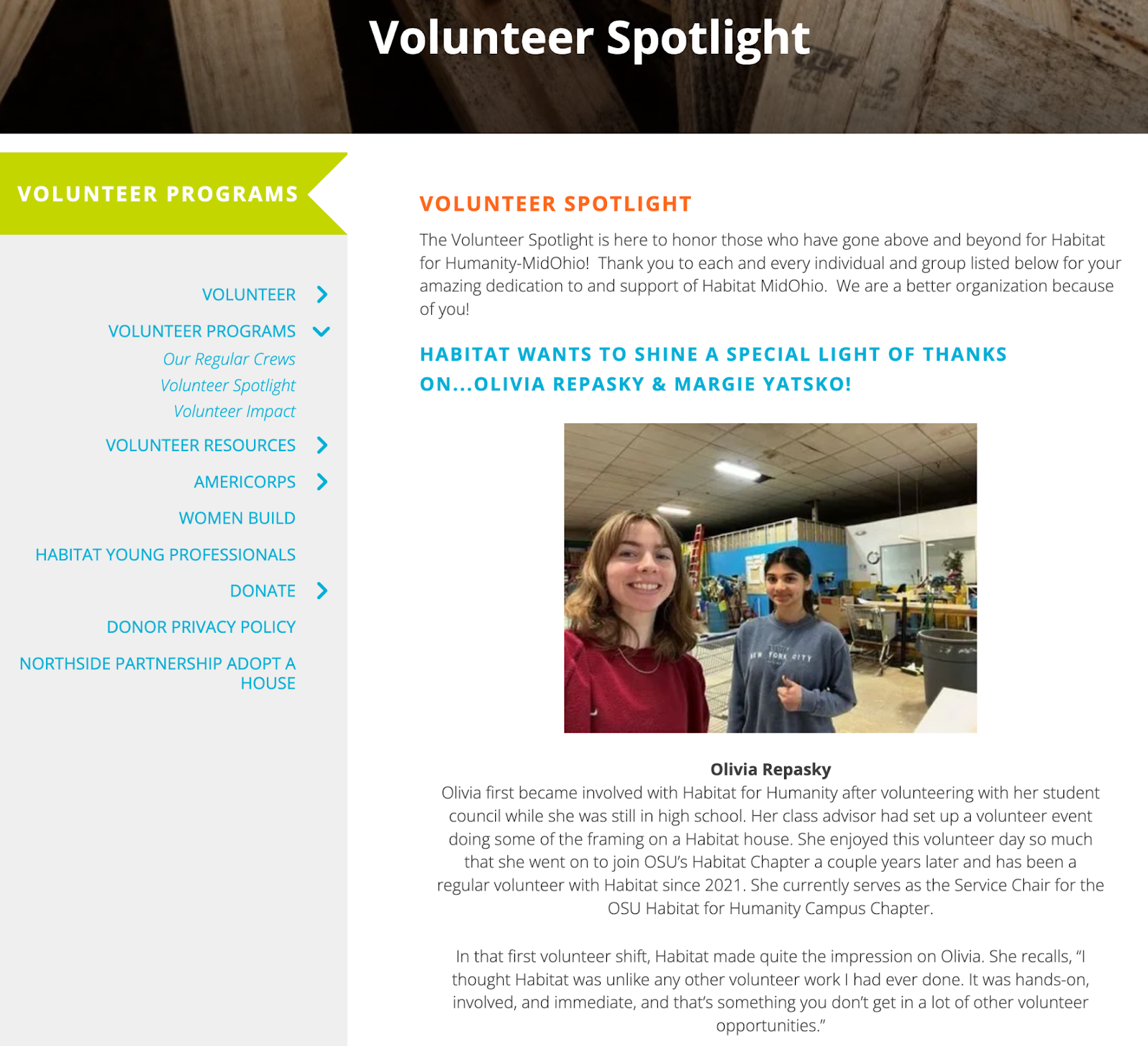
For comprehensive guidance on building an effective nonprofit website:
- What Should a Nonprofit Website Include (20 Must-Have Features)
- Nonprofit Website Redesign Guide
- How to Tell Your Nonprofit's Story Through Web Design
- 21 Nonprofit Website Best Practices [With Real-life Examples]
Partner and Board Testimonials
Professional endorsements from other organizations, community leaders, or board members build institutional credibility. These testimonials matter most when you're seeking partnerships, grants, or support from other professional entities.
Board member testimonials carry special weight because these individuals have chosen to commit significant time and expertise to your cause. Their endorsements speak to organizational effectiveness and mission alignment.
Partner testimonials from other nonprofits, government agencies, or businesses show that your organization plays well with others and delivers on collaborative commitments.
Staff and Leadership Testimonials
While less common, internal voices can add credibility in specific situations. Executive director perspectives might appear in grant applications or annual reports. Program staff testimonials can highlight the professional satisfaction that comes from working in mission-driven roles.
These testimonials work best when they focus on organizational culture, professional development, or the meaningful nature of the work rather than just general praise.
Collecting Testimonials Ethically and Effectively
Building a Testimonial Collection System
Creating a culture where story-sharing feels natural takes intentional effort. Start by making it easy for people to share their experiences when the moment feels right.
This might mean:
- Having simple feedback forms available at events
- Sending follow-up surveys after program completion
- Training staff to recognize when someone might be ready to share their story
Regular touchpoints for gathering feedback help you collect testimonials consistently rather than scrambling when you need them for a campaign.
Consider implementing:
- Quarterly check-ins with long-term donors
- Annual surveys for volunteers
- Celebration events where beneficiaries might naturally want to share their experiences
Multiple channels for collection ensure you're not missing opportunities. Some people prefer writing their thoughts, others are more comfortable speaking, and some might be willing to participate in a video but not write anything down.
The Art of the Ask
Requesting testimonials requires sensitivity, especially in the nonprofit world where relationships matter more than transactions. The key is timing your requests when people are already feeling positive about their experience with your organization.
- For Beneficiaries: Wait until they've had time to see real results from your programs.
- For Donors: Consider asking shortly after they've received impact updates that show how their gift made a difference.
- For Volunteers: The end of a successful project or event often provides a natural opening.
Make the request personal and specific. Instead of asking for "a testimonial," explain how their story could help others understand the value of supporting your cause. People are more likely to participate when they see how their experience could benefit your mission.
Ethical Considerations for Sensitive Populations
Working with vulnerable populations requires extra care in how you collect and use testimonials. Always obtain clear, written consent that explains exactly how their story will be used. Make sure people understand they can withdraw their permission at any time.
For minors, you'll need parent or guardian consent in addition to age-appropriate consent from the child. Consider whether using first names only or changing names entirely might be appropriate to protect privacy while still sharing the impact.
Some situations call for complete anonymization. Mental health services, addiction recovery programs, or domestic violence support might require removing any identifying details while still capturing the essence of the person's experience.
Interview Techniques That Get Great Stories
Follow these tips to capture compelling testimonials:
- Ask Open-Ended Questions: These elicit much better stories than simple yes-or-no prompts. Instead of asking "Did our program help you?" try "What was different about your life after participating in our program?" or "What would you tell someone who was considering getting involved with our organization?"
- Follow Up for Specifics: When someone says your program "really helped," ask them to describe what that help looked like day-to-day. Concrete details make testimonials more believable and impactful.
- Record Conversations: Recordings often produce more natural-sounding testimonials than asking people to write something from scratch. Many people find it easier to talk through their experience than to sit down with a blank page.
- Make Your Interviewees Comfortable: Start with easy questions about their background or how they first heard about your organization. Save the more emotional or challenging questions for after you've built some rapport.
Tools and Methods for Collection
Here are several methods for effectively collecting testimonials from volunteers, supporters, and recipients:
- Simple Survey Tools: Use survey tools like Google Forms or Typeform to capture written testimonials efficiently. Keep your questions short and focused—most people won't fill out lengthy forms no matter how much they appreciate your work.
- Video Testimonial Platforms: Platforms like StoryTap make it easier for people to record their own stories on their schedule. However, remember that not everyone is comfortable on camera, so always offer alternatives.
- Phone Interviews: Phone calls work well for people who are comfortable talking but might struggle with writing or technology. These conversations often produce the most natural-sounding content because people speak more conversationally than they write.
- In-Person Collection at Events: This strategy can be highly effective because people are already in a positive mindset about your organization. Having a staff member available with simple recording equipment (or even just a clipboard) can help you capture stories while they're fresh.
For more information about ethical content collection:
Crafting Compelling Testimonial Content
The most powerful testimonials feel authentic while still being clear and focused. When editing testimonials, your goal is to maintain the person's voice while ensuring their message comes through clearly.
Here’s how:
Get to the Heart of Each Testimonial
Start by identifying the core message in each testimonial. What's the main point this person wants to make about your organization? Build around that central theme while keeping their personal language and style intact.
Consider Optimal Length
Length considerations vary by platform and purpose. Website testimonials often work best at 50-100 words—long enough to feel substantial but short enough to be easily scannable. Email newsletter features might accommodate longer pieces, while social media requires much shorter snippets.
Add Meaningful Context
Adding context helps readers understand the significance of each testimonial without overwhelming the personal voice. A brief sentence explaining the person's relationship to your organization or the timeframe of their experience can make their story more meaningful.
Honor the People Behind the Testimonials
When including photos or videos with testimonials, make sure you have proper permissions and that the visual elements enhance rather than distract from the story. Poor quality photos can actually undermine the credibility of even the best testimonial content.
Proper attribution shows respect for the people sharing their stories while building credibility. Follow up with contributors before publishing to make sure they're comfortable with how their testimonial appears and that all details are accurate.
Real-Life Impact Done Right: Donna’s Story
The Heart and Stroke Foundation of Canada offers a standout example of how to present a testimonial with clarity, context, and heart. A striking quote from stroke survivor Donna Sharman draws readers in immediately, encouraging them to click through to learn more about her story.
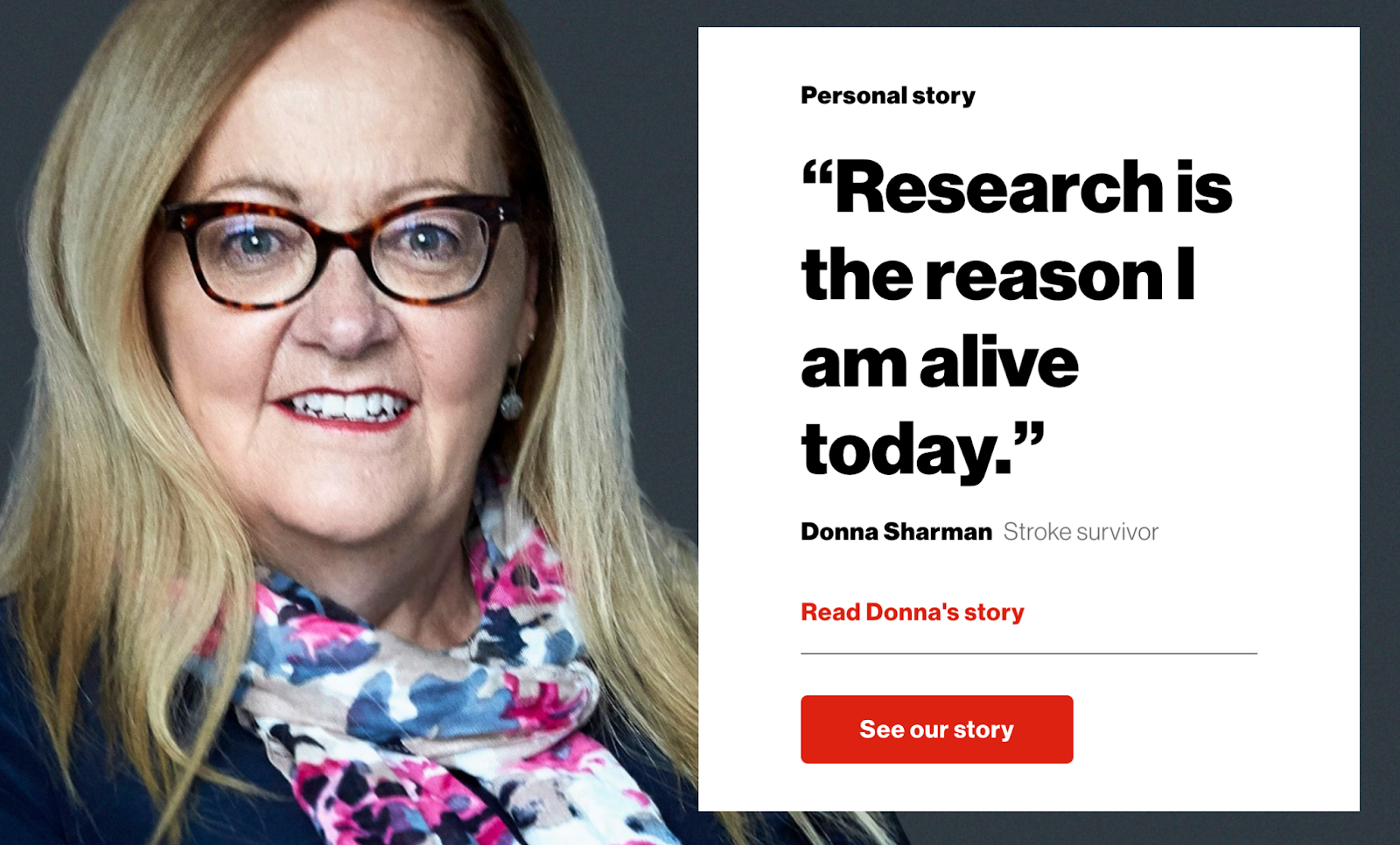
Once clicked, readers discover vivid, relevant details about Donna’s experience with the nonprofit—where she was when her stroke happened, the hospital she was taken to, and her involvement in a clinical trial. Interwoven with key facts about stroke research and care, the piece also includes thoughtful quotes from Donna and her husband that add another layer of authenticity.
Clean formatting, short paragraphs, and generous whitespace make the page easy to read and engaging from start to finish.
For more information about creating effective content:
- How to Write Effective Nonprofit Website Content: A Strategic Guide
- Nonprofit Blog Ideas: How to Create Content Your Community Will Love
- Nonprofit Landing Page Best Practices: A Comprehensive Guide
Strategic Website Placement and Display
Homepage Integration
Your homepage represents the first impression for many potential supporters, making testimonial placement crucial. Hero section testimonials can immediately communicate your impact, but they need to be powerful enough to grab attention without overwhelming your main message.
Social proof near donation buttons reduces hesitation by showing that others have found value in supporting your cause. This placement works especially well when the testimonial specifically mentions the positive experience of giving to your organization.
Donation Page Testimonials
Donation pages benefit from testimonials that reduce donor anxiety without creating distractions from the giving process. The best placement often appears before or alongside the donation form, where it can provide reassurance during the decision-making moment.
Choose testimonials for donation pages that specifically address common donor concerns, like stories about how:
- Gifts were used effectively
- Easy the donation process was
- Meaningful it felt to support the cause
These types of testimonials work better on donation pages than general organizational praise.
Short But Impactful: How Project Sweet Pea Incorporates Testimonials to Support Giving
Project Sweet Pea’s "Give" page features short but powerful testimonials alongside multiple ways to donate. These simple quotes add a personal touch that reinforces the impact of each donation (without overwhelming the page or distracting from the main call to action).
By keeping the stories brief and focused on how donations enabled the organization to support new parents in crisis, the nonprofit gently encourages visitors to follow through with their gift.
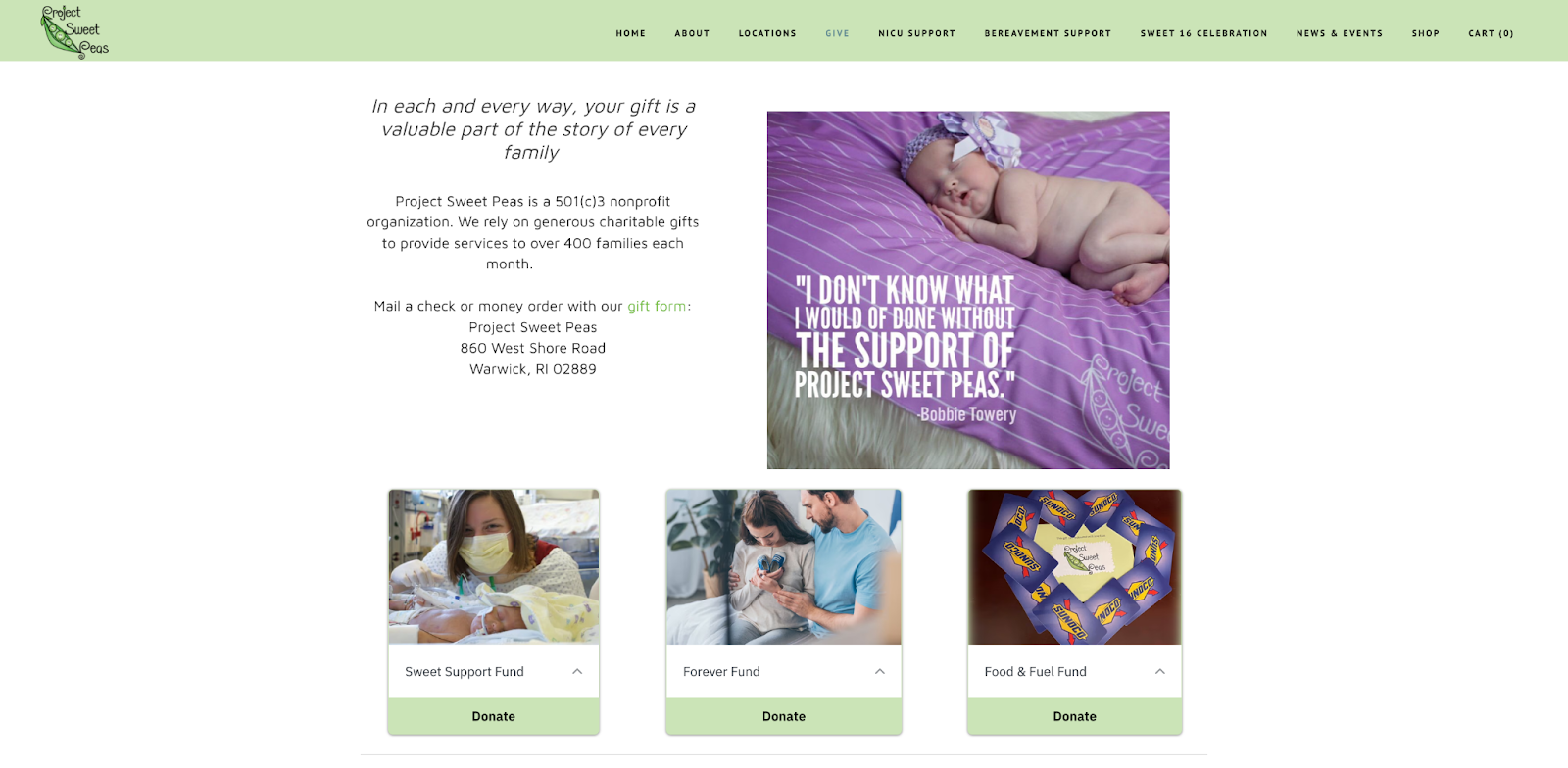
Program and Service Pages
Matching testimonials to specific programs helps visitors understand exactly what you do and how well you do it. These pages offer space for longer, more detailed stories that can include before-and-after elements naturally.
Geographic relevance can make testimonials more powerful when you serve specific communities. You can create a stronger connection with a testimonial from someone in the same city or region as a potential supporter than with a general endorsement.
About Us and Impact Pages
These sections work well for leadership and organizational testimonials that speak to your credibility and effectiveness. Board member endorsements fit naturally here, as do longer-term impact stories that show sustained change over time.
Long-term impact stories help donors see that their support creates lasting change rather than temporary assistance. These testimonials often work best when they include some element of time progression or ongoing relationship with your organization.
Blog and News Integration
Fresh testimonials as regular content keeps your story collection current and gives you material for ongoing communications. Seasonal testimonials tied to specific campaigns or annual events can create timely, relevant content.
Campaign-specific testimonials help potential supporters understand why particular initiatives matter and how previous supporters felt about participating.
For more information about website structure and design:
- How to Structure Your Nonprofit Website for Maximum Impact: A Complete Guide
- Donation Page Design: A Data-Driven Guide for Nonprofits
- Webflow for Nonprofit Websites: A Complete Guide
Cross-Channel Testimonial Strategy
Social Media Integration
Here’s how you can integrate testimonials into your social media strategy:
- LinkedIn Testimonials: These work particularly well for building professional credibility and reaching corporate donors or partners. The platform's business focus makes organizational endorsements feel natural and appropriate.
- Facebook and Instagram Story Features: Social stories allow you to share testimonials in engaging, visual formats that feel less formal than traditional marketing materials. These platforms work especially well for shorter testimonial snippets paired with compelling images.
- Social Media Posts: Craft social posts to amplify your website testimonials by driving traffic back to longer stories while providing quick impact snapshots for social audiences.
Email Marketing and Newsletters
Below are two ways to incorporate testimonials into donor communications to encourage continued support:
- Testimonial Spotlights: Spotlights in donor communications help supporters see the ongoing impact of their gifts while encouraging continued engagement. These work especially well in monthly or quarterly updates where you have space for more detailed stories.
- Follow-Up Messages: Impact stories in follow-up messages show single-time donors the specific results of their previous gifts to turn them into repeat supporters.
Fundraising Campaign Integration
Here are three types of testimonials to incorporate into your fundraising campaigns:
- Direct Mail Testimonials: These often perform well because they feel personal and authentic in a format that can sometimes seem impersonal. Choose stories that connect specifically to your campaign's goals and timeline.
- Grant Application Testimonials: These provide external validation of your work's effectiveness and community impact. Grant application testimonials often need to be more formal and detailed than testimonials used in donor communications.
- Annual Fundraising Drive Stories: Fundraising stories help create urgency and emotional connection during crucial giving periods. End-of-year testimonials that highlight the year's impact can be particularly effective.
Event and Outreach Applications
Strengthen your outreach with three different types of testimonials:
- Volunteer Recruitment Testimonials: Volunteer stories help potential volunteers see themselves in your organization and understand what they can expect from the experience. These work especially well when they address common concerns about time commitment or skills needed.
- Community Engagement Stories: Community stories help you build broader support by showing how your work benefits the entire community, not just direct beneficiaries.
- Partner Organization Outreach: This type of outreach benefits from testimonials that demonstrate your reliability and effectiveness as a collaborator.
For more information about comprehensive outreach strategies:
- 18 Proven Strategies to Increase Your Nonprofit Donations This Year
- How to Promote a Fundraiser
- Nonprofit Blog Ideas: How to Create Content Your Community Will Love
Design and User Experience Best Practices
Follow these best practices to design testimonials that are clear, engaging, and credible—so they resonate with every visitor, no matter how they access your site:
- Design to Enhance Credibility: Visual design should enhance testimonial credibility rather than distract from the content. Clean, simple layouts that highlight the human story work better than busy designs that compete for attention.
- Choose Photos Thoughtfully: Photo selection and placement can make or break a testimonial's impact. Select photos that feel authentic and connect to the story being told. Professional photography isn't always necessary, but images should be clear and appropriate to the tone of the testimonial.
- Prioritize Readability: Typography and readability considerations are especially important for testimonials since people need to be able to easily read and absorb the personal stories. Choose fonts and sizing that work well across different devices and age groups.
- Ensure Mobile-Responsiveness: Mobile-responsive testimonial displays ensure that your stories reach people however they're accessing your website. Since 53% of visitors to your nonprofit website will come from mobile devices, testimonials must work seamlessly on smaller screens.
Testimonials That Connect: Clear and Compassionate Design
Freedom Service Dogs of America's homepage features powerful testimonials from service dog recipients whose lives have been transformed by their canine partners. The testimonials shine thanks to a clean, easy-to-read layout that works seamlessly on both desktop and mobile devices. Clear typography, generous spacing, and thoughtfully placed images draw attention to each personal story without overwhelming the viewer, making the impact feel authentic and heartfelt.
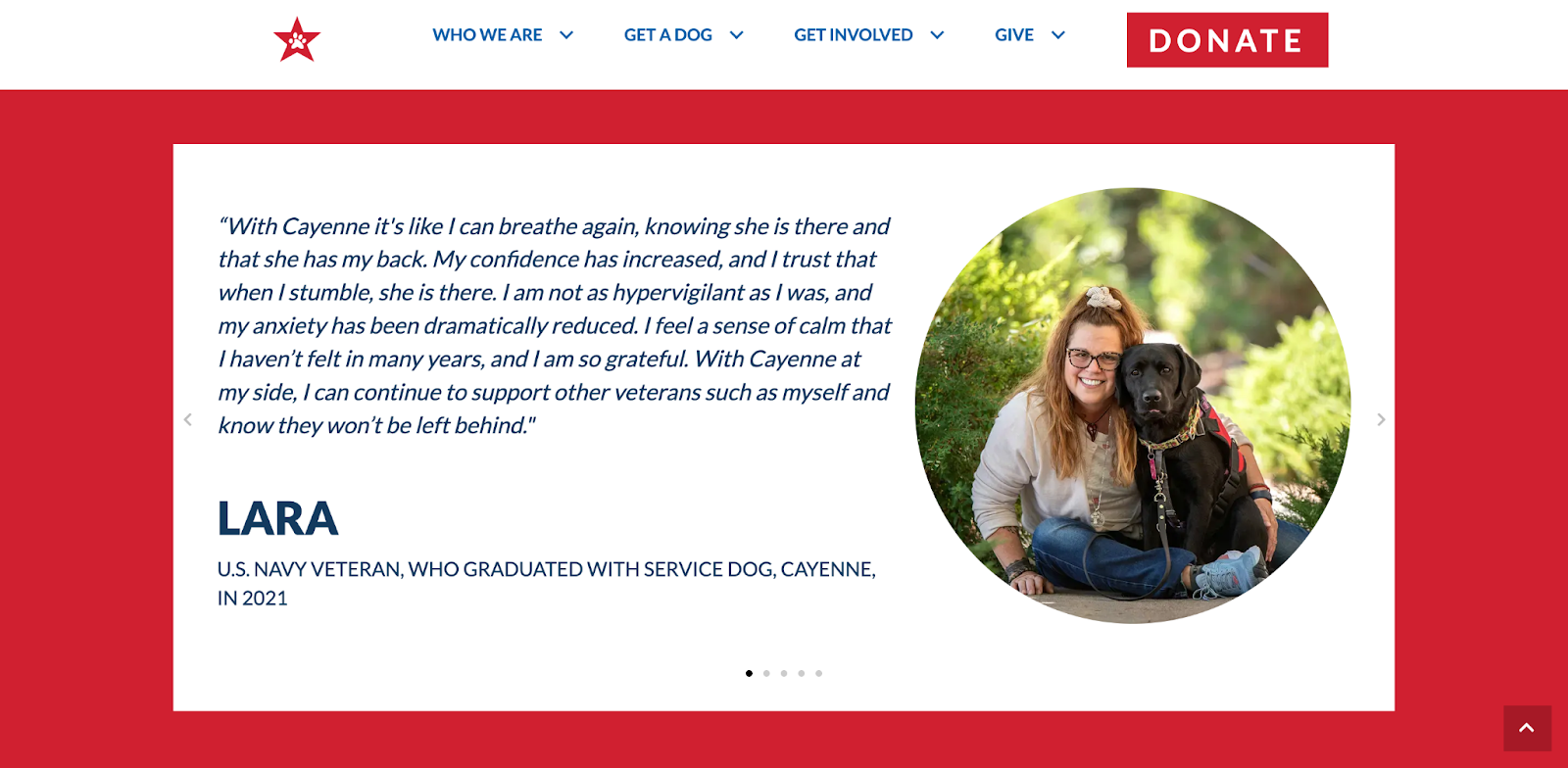
Format Options
Here are five effective ways to format your testimonials for maximum impact:
- Text-Only Testimonials: These work well when the words themselves are powerful and when you want to ensure fast loading times. Text-only testimonials often work best for shorter stories (or when you need to fit multiple stories on one page).
- Photo Testimonials: Photo testimonials add human connection and help readers relate to the person sharing their story. The combination of image and text often performs better than either element alone.
- Video Testimonials: Videos can be incredibly powerful but require more resources to produce and more bandwidth to display. Keep these brief and ensure they have captions for accessibility.
- Audio Testimonials: Audio testimonials offer a middle ground between text and video, capturing voice and emotion without requiring visual production. These work especially well for radio-style storytelling.
- Interactive Testimonial Galleries: Interactive galleries allow visitors to browse multiple stories and find ones that resonate with their interests or background.
For more information about inclusive design and visual content:
- Website Accessibility for Nonprofits: A Practical Guide
- Photography for Nonprofits: Ethics, Sourcing, and Impact
- Donation Page Design: A Data-Driven Guide for Nonprofits
- Nonprofit Landing Page Best Practices: A Comprehensive Guide
Technical Implementation and SEO Considerations
Focus on these key areas to effectively showcase and manage testimonials on your nonprofit website:
- Content Management Systems: Content management for testimonials benefits from simple systems that make it easy to add, update, and organize stories. Consider how you'll categorize testimonials by program, date, or type to make them easy to find and use.
- Choose Plugins Wisely: Testimonial plugins and widgets can streamline the display process, but choose tools that don't slow down your website or create accessibility barriers. Simple, custom solutions often work better than complex plugins.
- Database Organization: Database organization becomes important as your testimonial collection grows. Plan how you'll store permissions, contact information, and usage rights alongside the content itself.
- SEO Benefits: The search engine optimization (SEO) benefits of testimonial content include fresh, original content that search engines value, natural keyword usage that reflects how real people talk about your work, and increased time on page as visitors read engaging stories.
- Optimize Loading Speed: Loading speed and performance impacts matter because testimonials often include images or videos that can slow down your site. Optimize media files and consider lazy loading for pages with multiple testimonials.
For more information about technical optimization:
- Nonprofit Website SEO: A Complete Guide (2025)
- Nonprofit Website Speed Optimization: Why It Matters and How to Improve It
- Nonprofit Website Audits: A Comprehensive Guide for Evaluation
Legal and Privacy Considerations
When collecting and using testimonials, don’t forget to prioritize your legal and ethical responsibilities.
- Written Consent Requirements: Consent requirements vary by location and situation, but getting clear permission before using anyone's story protects both you and them. Your consent forms should specify exactly how you plan to use their testimonial and for how long.
- Releases for Photography and Video: Photography and video releases need to be separate from content permissions since visual media has different legal considerations. Make sure people understand whether their image will be used online, in print materials, or both.
- Transparent Privacy Policies: Privacy policies should address how you collect, store, and use testimonial content. Be transparent about data retention and give people options for how their information is handled.
- Data Storage and Security: This becomes important when you're maintaining files with personal stories and contact information. Ensure your security systems protect contributor privacy and comply with relevant regulations.
- Right to Withdraw Consent: This right should always be preserved. People's circumstances change, and they should be able to ask you to stop using their testimonial without penalty.
- International Regulations: Global considerations like GDPR affect how you handle testimonials from contributors in different countries. Understand what regulations apply to your organization and donor base.
For more information about privacy and legal requirements:
- Do Nonprofit Websites Need a Privacy Policy? A Complete Guide
- The Complete Guide to Nonprofit Website Security (2025)
- Website Accessibility for Nonprofits: A Practical Guide
Measuring Testimonial Effectiveness
Follow these tips to measure the effectiveness of your testimonials:
- Track Key Metrics: Key metrics to track include conversion rate improvements on pages with testimonials, time spent on pages featuring stories, and engagement rates for testimonial content across different channels.
- Use A/B Testing: A/B testing testimonial placement can help you understand what works best for your specific audience. Try testing different testimonials in the same location or the same testimonial in different positions.
- Focus on Donation and Signup Pages: Conversion rate improvements often show up most clearly on donation pages and volunteer sign-up forms where testimonials can directly influence decision-making.
- Gather Qualitative Feedback: Qualitative feedback about testimonial impact comes from asking donors and volunteers what influenced their decision to get involved. Many will mention specific stories that resonated with them.
- Review and Refresh Regularly: Regular refresh strategies ensure your testimonials stay current and relevant. Older testimonials can lose impact over time, especially if they reference outdated programs or circumstances.
For more information about tracking website performance:
- Nonprofit Website Metrics That Matter: KPIs to Track for Mission Success
- Nonprofit Website Speed Optimization: Why It Matters and How to Improve It
- Nonprofit Website Audits: A Comprehensive Guide for Evaluation
- Nonprofit Website Maintenance Guide
Common Mistakes to Avoid
Implement these techniques to steer clear of common pitfalls:
- Avoid Over-Editing: Over-editing testimonials until they lose authenticity defeats the purpose of using real people's words. While you should edit for clarity, maintain the person's voice and natural language patterns.
- Don’t Use Only Praise: Using only positive feedback makes your testimonials less believable. Include mild concerns that were addressed or challenges that were overcome to make stories more credible.
- Keep Testimonials Current: Neglecting to update testimonials regularly means your website starts to feel stale and outdated. Fresh stories show that your impact is ongoing rather than historical.
- Match Visuals Carefully: Poor photo quality or mismatched visuals can undermine even the best testimonial content. If you can't get good photos, text-only testimonials often work better than bad images.
- Limit the Quantity: Overwhelming users with too many testimonials on one page creates decision paralysis rather than persuasion. Choose your strongest stories and give them space to make an impact.
- Always Get Permission: Forgetting to get proper permissions creates legal and ethical problems that can damage relationships and expose your organization to liability.
- Avoid Generic Quotes: Generic testimonials that could apply to any organization don't help visitors understand what makes your work special or effective.
Action Steps for Bringing Your Mission to Life
Testimonials transform your website from a collection of claims into a showcase of real impact. They build trust, create emotional connections, and help potential supporters see themselves as part of your mission.
The most successful nonprofit websites treat testimonial collection as an ongoing process rather than a one-time project. Start by identifying the stories you already have access to, then build systems for collecting new ones regularly.
Begin your action plan with these five steps:
- Audit Your Existing Stories: Review communications, thank-you notes, and feedback you've already received for testimonial-worthy content.
- Choose Three Types of Testimonials to Focus on First: Start with the categories most relevant to your immediate goals.
- Create Simple Collection Tools: Set up basic forms or processes for gathering new testimonials.
- Identify Strategic Placement Opportunities: Choose 2-3 website locations where testimonials could have the biggest impact.
- Establish a Regular Review Schedule: Plan quarterly updates to keep your testimonials fresh and relevant.
Remember that the goal isn't perfection from the start. Begin with the testimonials you can collect easily and build your system over time. Every story you share helps potential supporters understand why your mission matters and how they can be part of creating positive change.
Your testimonials are evidence of hope in action. When you collect and share these stories thoughtfully, you're not just marketing your organization—you're amplifying the voices of the people whose lives have been touched by your mission.

